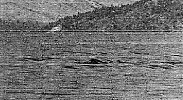 Research Research
How to photograph Ogopogo
Mike Paskal of Fort McMurray, Alberta, was holidaying with his family when he not only saw Ogopogo ("a large snakelike object, 80-90 feet long! It was big!"), but got the shot. "It's the best still photo of Ogopogo yet," says expert Arlene Gaal.
But if this one is the best, then the others are all worse, which leads us to believe that the following rules have the order of the day.
1. Don't use any equipment that is capable of being focused properly.
2. Try to film on a dreary day.
3. Don't shoot anything with too much contrast.
4. Preferably use 1000 ASA film (it's good and grainy, therefore virtually useless for enlargements).
5. Witnesses, if you simply can't avoid having them, should be hard of hearing, or have left their glasses in the car. This rule has been followed carefully in the past. If somebody really sees what you see, don't get their name or phone number.
6. It is quite acceptable to film with the lens cover on, especially if you are having a spectacular sighting - Ogopogo is right beside your boat or something. If this occurs, you do what one man did two summers ago: you shout out, "He had this wonderful jet-black color and this wonderful smooth skin! This time I left the blinking lens cap on the video camera. I had a still camera around my neck, but didn't use it." (Good man. That's sportsmanship.)
7. If you don't follow these suggestions, and do end up with some great footage, the only honorable thing to do is drop your camera overboard. Nippon TV slipped an expensive underwater camera into the waters off Squally Point last March, marking a grand finale to a long line of lost cameras.
8. As a very last resort, especially if you have obtained irrefutable evidence of a cryptid, it is suggested that you capsize your boat. This has only been done once.
Other tips
|


